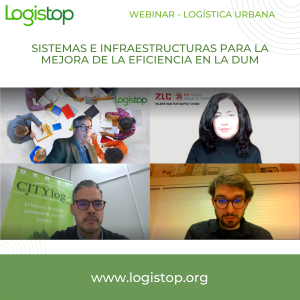- Lack of standardisation is one of the main problems facing the last mile.
- A harmonised framework and collaboration between stakeholders are two of the most important factors.
- Cities need to continue to work on incorporating urban logistics into their urban planning tools and plans.
In the Logistop Webinar “Systems and infrastructures for the improvement of efficiency in urban distribution of goods” we have deepened in the different systems that allow the improvement of goods distribution operations in cities through the creation of infrastructures and means for the improvement of efficiency in urban distribution of goods and the integration of more sustainable processes and collaboration between the participating agents, also seeing real examples of projects developed or under development.
For this, we have counted on the participation of Daniel Latorre, leader of the Urban Logistics Working Group of Logistop and development director of Citylogin Iberia, Antoine Radal, expert of the Urban Logistics Working Group of Logistop and urban distribution of goods specialist consultant at Interface Transport, Carolina Ciprés, research director at Zaragoza Logistics Center, and the moderation of Tomás de la Vega, managing director of Logistop.

First, Daniel Latorre gave a brief introduction of the context and current situation of urban logistics in Spain, focusing on four key aspects: 1) the lack of knowledge about the last mile; 2) taking into account sustainability, not only from an environmental point of view but also from an economic perspective; 3) collaboration between the stakeholders involved; and 4) highlighting the importance of training delivery drivers. He added that one of the main problems to be faced is the lack of standardisation of systems and the need to work with data that allows us to convert it into information that can lead to innovative actions that improve distribution in the last mile.
Daniel also presented the new lines of work that we will develop over the course of this year at Logistop: urban freight infrastructures for the HORECA sector, multimodality in DUM, hydrogen hubs for urban distribution of goods in municipalities, measurement and certification of the carbon footprint, urban distribution of goods at night, and implementation of autonomous vehicles.
“The standardisation of processes from a technological point of view could avoid the current need for IT system integrations that allow the use of collaborative platforms that help to reduce the use of public space and the development of innovation”
Daniel Latorre, leader of the Urban Logistics Working Group of Logistop and development director of Citylogin Iberia
For his part, Antoine Radal, in the first part of his speech, highlighted the benefits of night and silent deliveries (in terms of operations and energy, environmental, social and economic benefits), as well as the need for public-private collaboration to ensure the success of this modality. Likewise, given the increased complexity of access to urban centres for logistics operators, taking into account city regulations and congestion problems, as well as the need to reduce environmental impact, it is indicated that a modal shift would induce an additional load break representing an economic risk and, if this shift were carried out by public rail transport, it would allow this risk to be minimised.
In the second part of his speech, Antoine presented to the audience a series of projects that have been carried out in different European cities with the aim of improving the existing situation in different areas of urban freight distribution.
“It is absolutely necessary and fundamental to integrate logistics into urban planning. This integration will allow us, in the medium term, to develop and work on new initiatives and multimodal infrastructure projects that will improve the urban distribution of good”
Antoine Radal,expert of the Urban Logistics Working Group of Logistop and urban distribution of goods specialist consultant at Interface Transport
Finally, Carolina Ciprés highlights the importance of multimodality in promoting zero-emission logistics. In this sense, for example, mobile hubs allow us to combine storage functions (not only for goods, but also for small delivery vehicles, such as bicycles, for example) as well as delivery functions. Likewise, synchromodal hubs will not only allow us to combine sections according to the distribution of cities and the location of centres, among other aspects, but will also provide agility in decision-making based on real-time data.
To conclude, Carolina presented demonstrators in different cities in the framework of the European projects Sprout, Lead and Solutionsplus in which they are involved, and working on sustainable and innovative policies for the transition in urban mobility, adaptive last-mile and low-emission logistics in support of the on-demand economy through “digital twins” and in accelerating the transformational change towards sustainable urban mobility through innovative and integrated electric mobility solutions, respectively.
“In recent years, we have made great strides not only in terms of solutions, but also in raising the awareness of cities to incorporate logistics into urban mobility planning. City councils may have the will to incorporate it, but they do not necessarily have to know the solutions, and this is where collaboration with private entities is necessary”
Carolina Ciprés, research director at Zaragoza Logistics Center
Logistop is the leading workspace for collective innovation through the realisation of projects hand in hand with our members. Transforming the entire supply chain into a more efficient and sustainable one. All of this with the objective of articulating and carrying out innovation projects between members, without excluding the possibility of collaborating with or receiving support from certain organisations external to Logistop.
In the Urban Logistics Working Group we deal with the optimisation and efficiency of operations, the total transformation of delivery modes, the use of proximity warehouses and the active collaboration between city councils, public and private companies and the use of technology. More information on this link.
